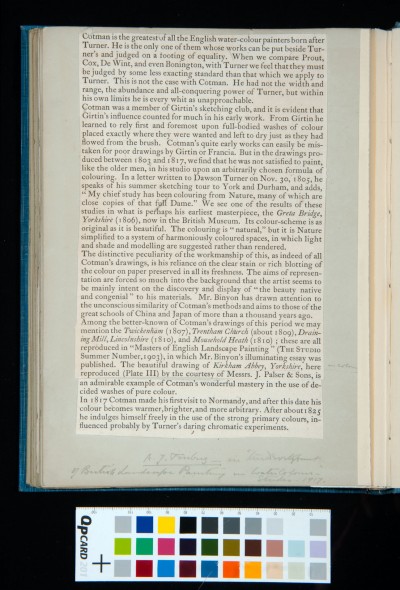Cotmania. Vol. III. 1928-9
Archive: SDK Sydney Decimus Kitson Archive
Reference Number: SDK/1/2/1/3
Page: 30 verso
-
Description
Clipping from A. J. Finburg, 'The Development of British Landscape Painting in Watercolours', 1917
Clipping from A. J. Finburg, 'The Development of British Landscape Painting in Watercolours', 1917
Date:
-
Transcription
Cotman is the greatest of all the English water-colour painters born after Turner. He is the only one of them whose works can be put beside Turner's and judged on a footing of equal quality. When we compare Prout, Cox, de Wint, and even Bonington, with Turner we feel that they must be judged by some less exacting standard that that which we apply to Turner. That is not the case with Cotman. He had not the width and range, the abundance and all-conquering power of Turner, but within his own limits he is every whit as unapproachable.
Cotman was a member of Girtin's sketching club, and it is evident that Girtin's influence counted for much in his early work. From Girtin he learned to rely first and foremost upon full-bodied washes of colour placed exactly where they were wanted and left to dry just as they had flown from the brush. Cotman's quite early works can easily be mistaken for poor drawings by Girtin or Francia. But in the drawing produced between 1803 and 1817, we find that he was not satisfied to paint, like the older men, in his studio upon an arbitrarily chosen formula of colouring. In a letter written to Dawson Turner on Nov. 30. 1805, he speaks of his summer sketching tour to York and Durham, and adds, "My chief study has been colouring from nature many of which are close copies of that [[full]] {Kitson crossed it out} Dame." We see one of the result from these studies in what is perhaps his earliest masterpiece, the Greta Bridge, Yorkshire (1806), now in the British Museum. Its colour-scheme is as original as it is beautiful. The colouring is "natural" but it is Nature simplified to a system of harmoniously coloured spaces, in which light and shade and modelling are suggested rather than rendered.
The distinctive peculiarity of the workmanship of this , as indeed of all Cotman's drawings, is his reliance on the clear stain or rich blotting of the colour in paper preserved in all its freshness. The aims of representation are forced so much in to the background that the artist seems to be mainly intent on the discovery and display of "the beauty native and congenial" to his materials. Mr. Binyon has drawn attention to the unconscious similarity of Cotman's methods and aims to those of the great schools of China and Japan of more than a thousand years ago.
Among the better know of Cotman's drawings of this period we may mention the Twickenham (1807), Trentham Church (about 1809), Draining Mill, Lincolnshire (1810), and Mousehold Heath (1810); these aer all reproduced in "Masters of English Landscape Painting" (The Studio Summer Number, 1903), in which Mr Binyon's illuminating essay was published. The beautiful drawing of Kirkham Abbey, Yorkshire, here reproduced (plate III) by the courtesy of Messrs. J. Palser & Sons, is an admirable copy of Cotman's wonderful mastery in the use of decided washes of pure colour.
In 1817 Cotman made his first visit to Normandy, and after this date his colour becomes warmer, brighter and more arbitrary. After about 1825 he indulges himself freely in the use of the strong primary colours, influenced probably by Turner's daring chromatic experiments.A. J. Finburg, in 'the Development of British Landscape Painting in Watercolours'- Studio, 1917.
